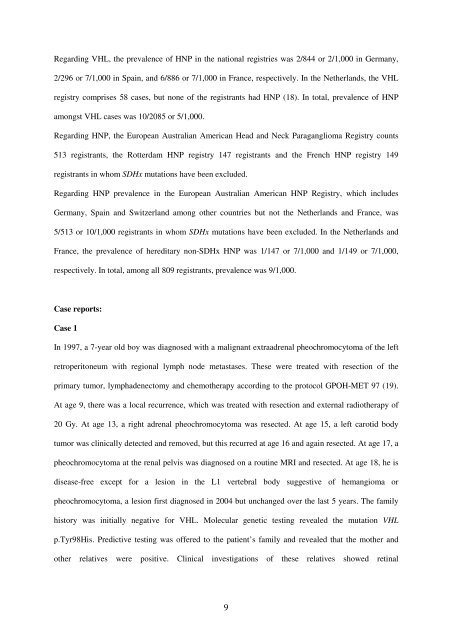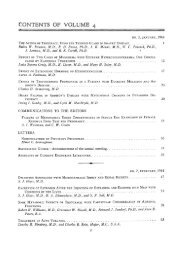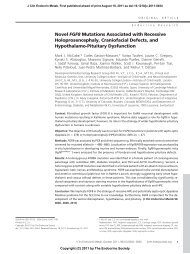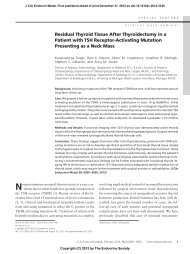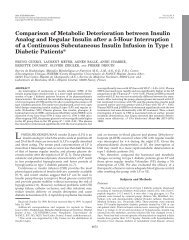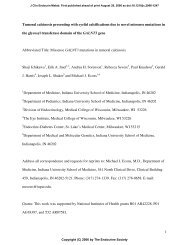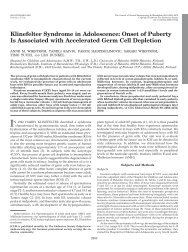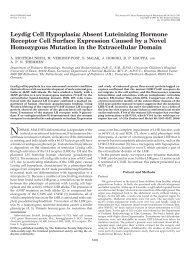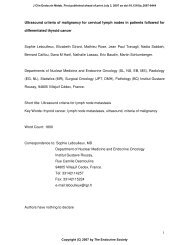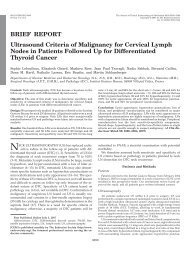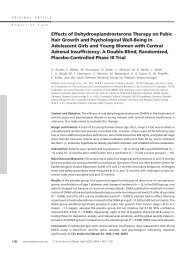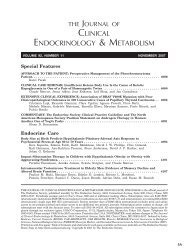Head and Neck Paragangliomas in Von Hippel-Lindau Disease and ...
Head and Neck Paragangliomas in Von Hippel-Lindau Disease and ...
Head and Neck Paragangliomas in Von Hippel-Lindau Disease and ...
Create successful ePaper yourself
Turn your PDF publications into a flip-book with our unique Google optimized e-Paper software.
Regard<strong>in</strong>g VHL, the prevalence of HNP <strong>in</strong> the national registries was 2/844 or 2/1,000 <strong>in</strong> Germany,<br />
2/296 or 7/1,000 <strong>in</strong> Spa<strong>in</strong>, <strong>and</strong> 6/886 or 7/1,000 <strong>in</strong> France, respectively. In the Netherl<strong>and</strong>s, the VHL<br />
registry comprises 58 cases, but none of the registrants had HNP (18). In total, prevalence of HNP<br />
amongst VHL cases was 10/2085 or 5/1,000.<br />
Regard<strong>in</strong>g HNP, the European Australian American <strong>Head</strong> <strong>and</strong> <strong>Neck</strong> Paraganglioma Registry counts<br />
513 registrants, the Rotterdam HNP registry 147 registrants <strong>and</strong> the French HNP registry 149<br />
registrants <strong>in</strong> whom SDHx mutations have been excluded.<br />
Regard<strong>in</strong>g HNP prevalence <strong>in</strong> the European Australian American HNP Registry, which <strong>in</strong>cludes<br />
Germany, Spa<strong>in</strong> <strong>and</strong> Switzerl<strong>and</strong> among other countries but not the Netherl<strong>and</strong>s <strong>and</strong> France, was<br />
5/513 or 10/1,000 registrants <strong>in</strong> whom SDHx mutations have been excluded. In the Netherl<strong>and</strong>s <strong>and</strong><br />
France, the prevalence of hereditary non-SDHx HNP was 1/147 or 7/1,000 <strong>and</strong> 1/149 or 7/1,000,<br />
respectively. In total, among all 809 registrants, prevalence was 9/1,000.<br />
Case reports:<br />
Case 1<br />
In 1997, a 7-year old boy was diagnosed with a malignant extraadrenal pheochromocytoma of the left<br />
retroperitoneum with regional lymph node metastases. These were treated with resection of the<br />
primary tumor, lymphadenectomy <strong>and</strong> chemotherapy accord<strong>in</strong>g to the protocol GPOH-MET 97 (19).<br />
At age 9, there was a local recurrence, which was treated with resection <strong>and</strong> external radiotherapy of<br />
20 Gy. At age 13, a right adrenal pheochromocytoma was resected. At age 15, a left carotid body<br />
tumor was cl<strong>in</strong>ically detected <strong>and</strong> removed, but this recurred at age 16 <strong>and</strong> aga<strong>in</strong> resected. At age 17, a<br />
pheochromocytoma at the renal pelvis was diagnosed on a rout<strong>in</strong>e MRI <strong>and</strong> resected. At age 18, he is<br />
disease-free except for a lesion <strong>in</strong> the L1 vertebral body suggestive of hemangioma or<br />
pheochromocytoma, a lesion first diagnosed <strong>in</strong> 2004 but unchanged over the last 5 years. The family<br />
history was <strong>in</strong>itially negative for VHL. Molecular genetic test<strong>in</strong>g revealed the mutation VHL<br />
p.Tyr98His. Predictive test<strong>in</strong>g was offered to the patient’s family <strong>and</strong> revealed that the mother <strong>and</strong><br />
other relatives were positive. Cl<strong>in</strong>ical <strong>in</strong>vestigations of these relatives showed ret<strong>in</strong>al<br />
9


